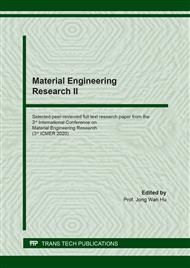[1]
V. R. Sagar, P. Suresh Kumar, Recent advances in drying and dehydration of fruits and vegetables: a review, J. Food. Sci. Technol. 47 (2010) 15-26.
DOI: 10.1007/s13197-010-0010-8
Google Scholar
[2]
J. Ahemed, D. R. Choudhary, Osmotic dehydration of papaya, Indian Food Pack. 49 (1995) 5-11.
Google Scholar
[3]
M. M. Odewole, O. Adeyinka-Ajiboye, Z. O. Ayodimeji, R. O. Adako, Application of response surface methodology (rsm) to the study of mass transfer parameters of osmo-pretreated and dried green bell pepper, Annals. Food Sci. Technol. 17(2) (2016) 426-433.
Google Scholar
[4]
B. Ibitwar, B. Kaur, S. Arora, P. B. Pathare, Osmo-convective dehydration of plum (Prunus salicina L.), Int. J. Food. Eng. 4(8) (2008) 1-11.
DOI: 10.2202/1556-3758.1286
Google Scholar
[5]
M. Sainakham, A. Manosroi, M. Abe, W. Manosroi, J. Manosroi, Potent in vivo anticancer activity and stability of liposomes encapsulated with semi-purified Job's tear (Coix lacryma-jobi Linn.) extracts on human colon adenocarcinoma (HT-29) xenografted mice, Drug. Deliv. 23(9) (2016) 3399-3407.
DOI: 10.1080/10717544.2016.1189464
Google Scholar
[6]
S.C. Li, C. M. Chen, S. H. Lin, Effects of adlay bran and its ethanolic extract and residue on preneoplastic lesions of the colon in rats, J. Sci. Food. Agric. 91 (2011) 547-552.
DOI: 10.1002/jsfa.4219
Google Scholar
[7]
T. Fuentes-Ortega, S. L. Mart´ınez-Vargas, S. Cortes-Camargo, A. Yazmin Guadarrama-Lezama, R. Gallardo-Rivera, R. Baeza-Jimenez, C. Perez-Alonso, Effects of the process variables of microencapsulation sesame oil (Sesamum indica L.) by spray drying, Rev. Mex. Ing. Quim. 16(2) (2017) 477-490.
Google Scholar
[8]
M. S. Wu, L. B. B. Aquino, M. Y. U. Barbaza, C. L. Hsieh, K. A. D. Castro-Cruz, L. L. Yang, P. W. Tsai, Anti-inflammatory and anticancer properties of bioactive compounds from Sesamum indicum L.-A review, Molecules, 24 (4426) (2019) 1-28.
DOI: 10.3390/molecules24244426
Google Scholar
[9]
P. Pasukamonset, O. Kwon, S. Adisakwattana, Alginate-based encapsulation of polyphenols from Clitoria ternatea petal flower extract enhances stability and biological activity under simulated gastrointestinal conditions, Food Hydrocoll. 61 (2016) 772-779.
DOI: 10.1016/j.foodhyd.2016.06.039
Google Scholar
[10]
C. G. D. Rosa, C. D. Borges, R. C. Zambiazi, J. K. Rutz, S. R. da Luz, F. D. Krumreich, Encapsulation of the phenolic compounds of the blackberry (Rubus fruticosus). LWT-Food. Sci. Technol. 58 (2014) 527-533.
DOI: 10.1016/j.lwt.2014.03.042
Google Scholar
[11]
T. Chimsook, Thailand Petty Patent 1703002556. (2018) in press.
Google Scholar
[12]
P. S. Sunkja, G. S. V. Ragharan, Assessment of pre treatment methods and osmotic dehydration of Cranberries, J. Canadian Bio. Syst. 46 (2004) 52-56.
Google Scholar
[13]
P. S. Pisalkar, N. K. Jain, P. B. Pathare, R. P. Murumkar, V. A. Revaskar, Osmotic dehydration of aloe vera cubes and selection of suitable drying model, Int. Food Res. 21 (2014) 373-378.
Google Scholar
[14]
J. Li, S. Y. Kim, X. Chen, H. J. Park, Calcium-alginate beads loaded with gallic acid: Preparation and characterization, LWT-Food Sci Technol. 68 (2016) 667-673.
DOI: 10.1016/j.lwt.2016.01.012
Google Scholar
[15]
U. D. Chavan, Osmotic dehydration process for preservation of fruits and vegetables, J. Food. Res. 1 (2012) 202-209.
Google Scholar
[16]
A. P. Chaudhari, B. K. Kumbhar, B. N. N. Singh, M. Narain, Osmotic dehydration of fruits and vegetables, Indian. Food. Indus. 12 (1993) 20-27.
Google Scholar


